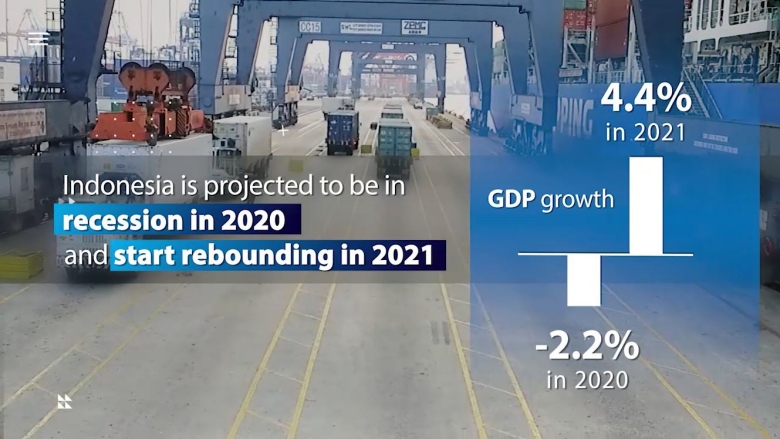Download the report (.pdf) | Executive summary (Bahasa .pdf) | The launch event
MULTIMEDIA

Key Findings:
- Indonesia’s economy is slowly recovering during the second half of 2020 aided by the gradual re-opening of the domestic and global economies and massive policy support. The pace of economic contraction slowed to 3.5% year-over-year (yoy) in Q3 2020 from a 5.3% yoy in Q2 2020, driven by a partial recovery in consumption – including a significant increase in public spending – investment and net exports. Capital flows have stabilized, and the Rupiah has recovered from its large depreciation in March-April.
- The impact of the crisis is lingering. Domestic demand is still significantly weaker than before the crisis (2.8% below its 2019 level as of September). Unemployment rate rose by 1.8 percentage points to 7.1% and the underemployment rate increased by 3.8 percentage points to 10.2% in the third quarter compared to the year before.
- But the pace of recovery is also uneven across sectors. Contact-intensive sectors which rely more on face-to-face interactions including with customers – including transport, hospitality, wholesale and retail trade, construction, manufacturing – were hit particularly hard and have only partially recovered. Less contact-intensive sectors – such as finance, education, communication and telecommunication – were more resilient. Sectors that are more exposed to foreign demand – (such as mining and manufacturing) were partially shielded by the rebound in trade and some commodity prices from their lows in mid-2020.
- The monetary response to the crisis has been strong. Bank Indonesia’s local-currency government bond purchase program (1.8% of GDP in August compared to 1.7% of GDP on average among emerging markets) has helped maintain financial stability and finance the fiscal deficit. It has also contributed to lowering long-end local currency government bond yields. But the program involves macro-financial tradeoffs that need to be managed.
- The government’s strong fiscal response to save lives and livelihoods and stimulate the recovery (4.3% of GDP) has been decisive.
- Indonesia is poised to finish this year with its first recession in two decades. The World Bank’s growth projection for 2020 is revised to -2.2% from -1.6% in September, reflecting weaker-than-expected recovery in the third quarter and part of the fourth quarter, while mobility restrictions and social distancing must still be reinforced amid rising COVID-19 cases.
- With a steady reopening of the economy in 2021 followed by further reopening and decline in social distancing through 2022, growth would rebound to 4.4% in 2021. Stronger consumption and investment would further strengthen growth to 4.8% in 2022 as confidence improves, provided an effective and safe vaccine is available to a large part of the population.
- But the Indonesian and global economies face very high downside risks. Growth could drop to 3.1% in 2021 and 3.8% in 2022 under a downside scenario of severe tightening of mobility restrictions in Indonesia, and weaker global growth and commodity prices.
- The report recommends that Indonesia focus on securing and accelerating the recovery by:
- Prioritizing public health to ensure that the economy can move towards full reopening by strengthening testing and contract tracing, and preparing to widely administer an effective and safe vaccine once it is approved;
- Maintaining support to affected and vulnerable households and firms, and continuously monitor and improve the effectiveness of the programs;
- Developing well prioritized tax and expenditure reforms to help finance the crisis response, reduce financing needs and improve the fiscal space;
- Advancing structural reforms to boost investment, productivity and human capital and lift Indonesia’s potential growth.
- The report also discusses how to address Indonesia’s food security challenges and modernize the agri-food system. The report recommends the following to meet the government’s renewed food security goals in the wake of the COVID-19 crisis:
- Broaden the food security agenda to move beyond self-sufficiency in rice and other strategic commodities and shift to consider availability, affordability and quality for all.
- Adjust policy goals and instruments to focus more on enhancing agricultural productivity, crop diversification and competitiveness
- Improve public spending to enhance productivity, innovation, food quality, and food safety.